stop start TOYOTA BZ4X 2022 (in English) Manual Online
[x] Cancel search | Manufacturer: TOYOTA, Model Year: 2022, Model line: BZ4X, Model: TOYOTA BZ4X 2022Pages: 674, PDF Size: 120.02 MB
Page 404 of 674
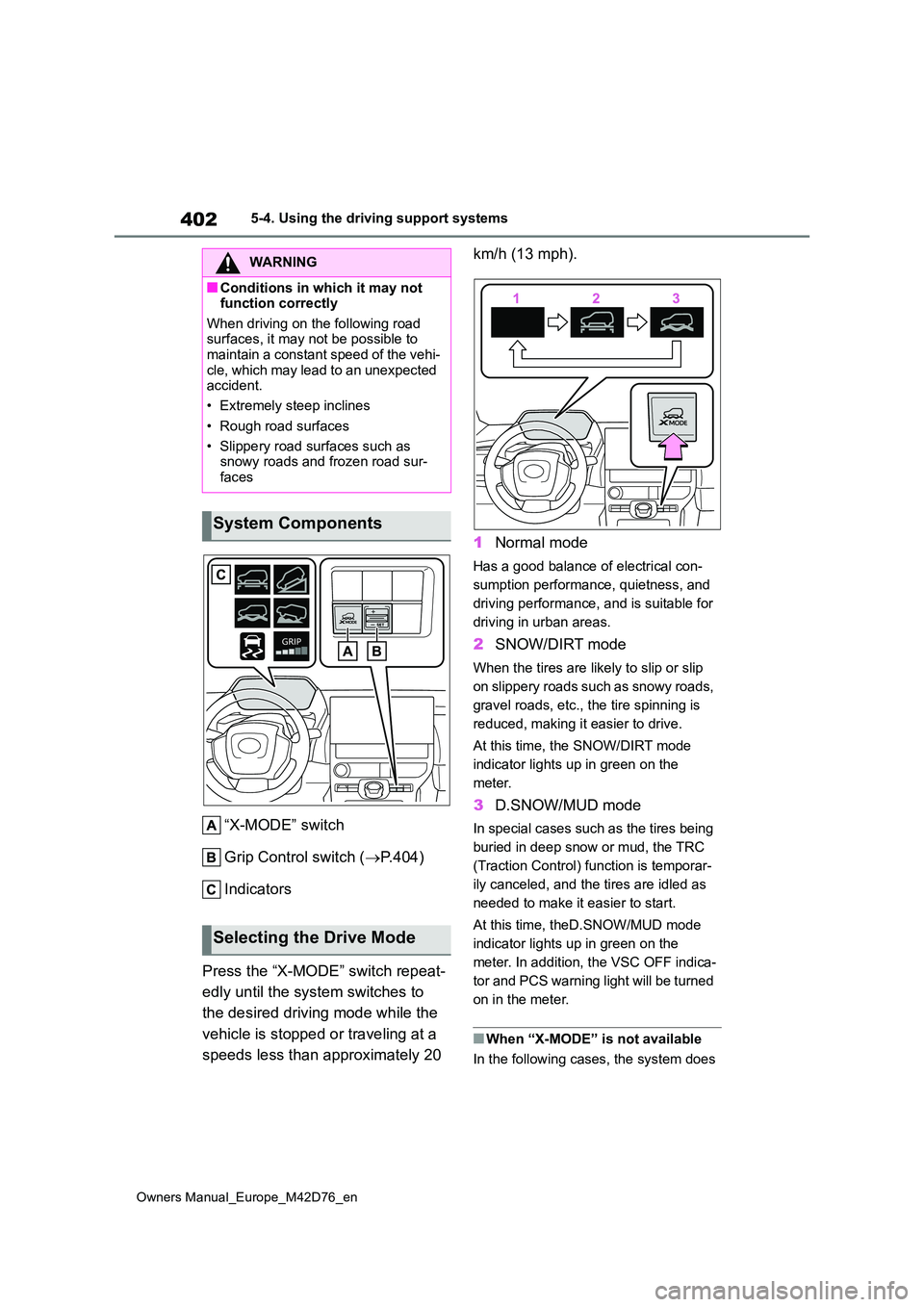
402
Owners Manual_Europe_M42D76_en
5-4. Using the driving support systems
“X-MODE” switch
Grip Control switch ( P.404)
Indicators
Press the “X-MODE” switch repeat-
edly until the system switches to
the desired driving mode while the
vehicle is stopped or traveling at a
speeds less than approximately 20
km/h (13 mph).
1 Normal mode
Has a good balance of electrical con-
sumption performance, quietness, and
driving performance, and is suitable for
driving in urban areas.
2 SNOW/DIRT mode
When the tires are likely to slip or slip
on slippery roads such as snowy roads,
gravel roads, etc., the tire spinning is
reduced, making it easier to drive.
At this time, the SNOW/DIRT mode
indicator lights up in green on the
meter.
3 D.SNOW/MUD mode
In special cases such as the tires being
buried in deep snow or mud, the TRC
(Traction Control) function is temporar-
ily canceled, and the tires are idled as
needed to make it easier to start.
At this time, theD.SNOW/MUD mode
indicator lights up in green on the
meter. In addition, the VSC OFF indica-
tor and PCS warning light will be turned
on in the meter.
■When “X-MODE” is not available
In the following cases, the system does
WARNING
■Conditions in which it may not function correctly
When driving on the following road surfaces, it may not be possible to maintain a constant speed of the vehi-
cle, which may lead to an unexpected accident.
• Extremely steep inclines
• Rough road surfaces
• Slippery road surfaces such as snowy roads and frozen road sur-
faces
System Components
Selecting the Drive Mode
Page 406 of 674
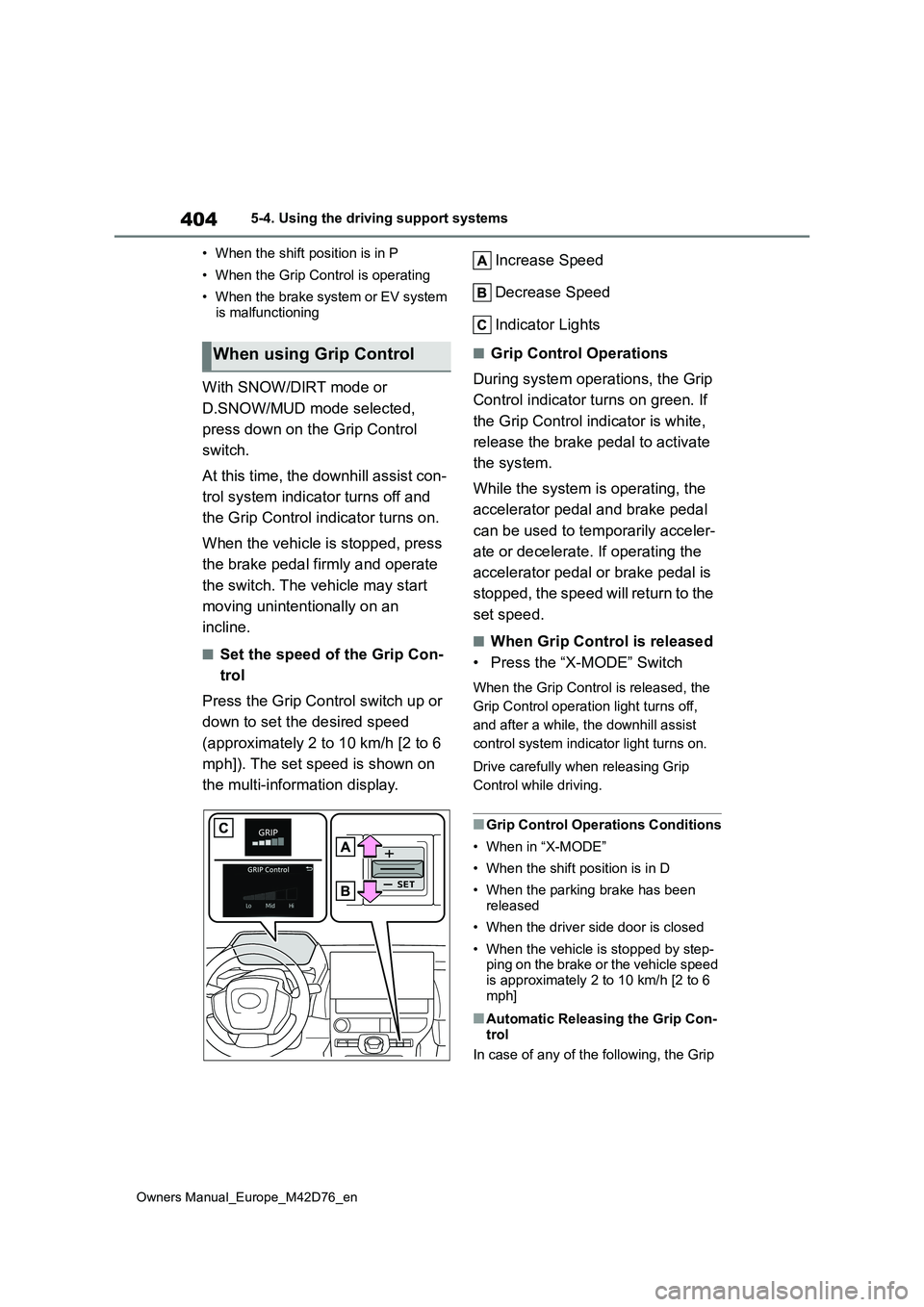
404
Owners Manual_Europe_M42D76_en
5-4. Using the driving support systems
• When the shift position is in P
• When the Grip Control is operating
• When the brake system or EV system is malfunctioning
With SNOW/DIRT mode or
D.SNOW/MUD mode selected,
press down on the Grip Control
switch.
At this time, the downhill assist con-
trol system indicator turns off and
the Grip Control indicator turns on.
When the vehicle is stopped, press
the brake pedal firmly and operate
the switch. The vehicle may start
moving unintentionally on an
incline.
■Set the speed of the Grip Con-
trol
Press the Grip Control switch up or
down to set the desired speed
(approximately 2 to 10 km/h [2 to 6
mph]). The set speed is shown on
the multi-information display.
Increase Speed
Decrease Speed
Indicator Lights
■Grip Control Operations
During system operations, the Grip
Control indicator turns on green. If
the Grip Control indicator is white,
release the brake pedal to activate
the system.
While the system is operating, the
accelerator pedal and brake pedal
can be used to temporarily acceler-
ate or decelerate. If operating the
accelerator pedal or brake pedal is
stopped, the speed will return to the
set speed.
■When Grip Control is released
• Press the “X-MODE” Switch
When the Grip Control is released, the
Grip Control operation light turns off,
and after a while, the downhill assist
control system indicator light turns on.
Drive carefully when releasing Grip
Control while driving.
■Grip Control Operations Conditions
• When in “X-MODE”
• When the shift position is in D
• When the parking brake has been
released
• When the driver side door is closed
• When the vehicle is stopped by step- ping on the brake or the vehicle speed
is approximately 2 to 10 km/h [2 to 6 mph]
■Automatic Releasing the Grip Con-trol
In case of any of the following, the Grip
When using Grip Control
Page 407 of 674
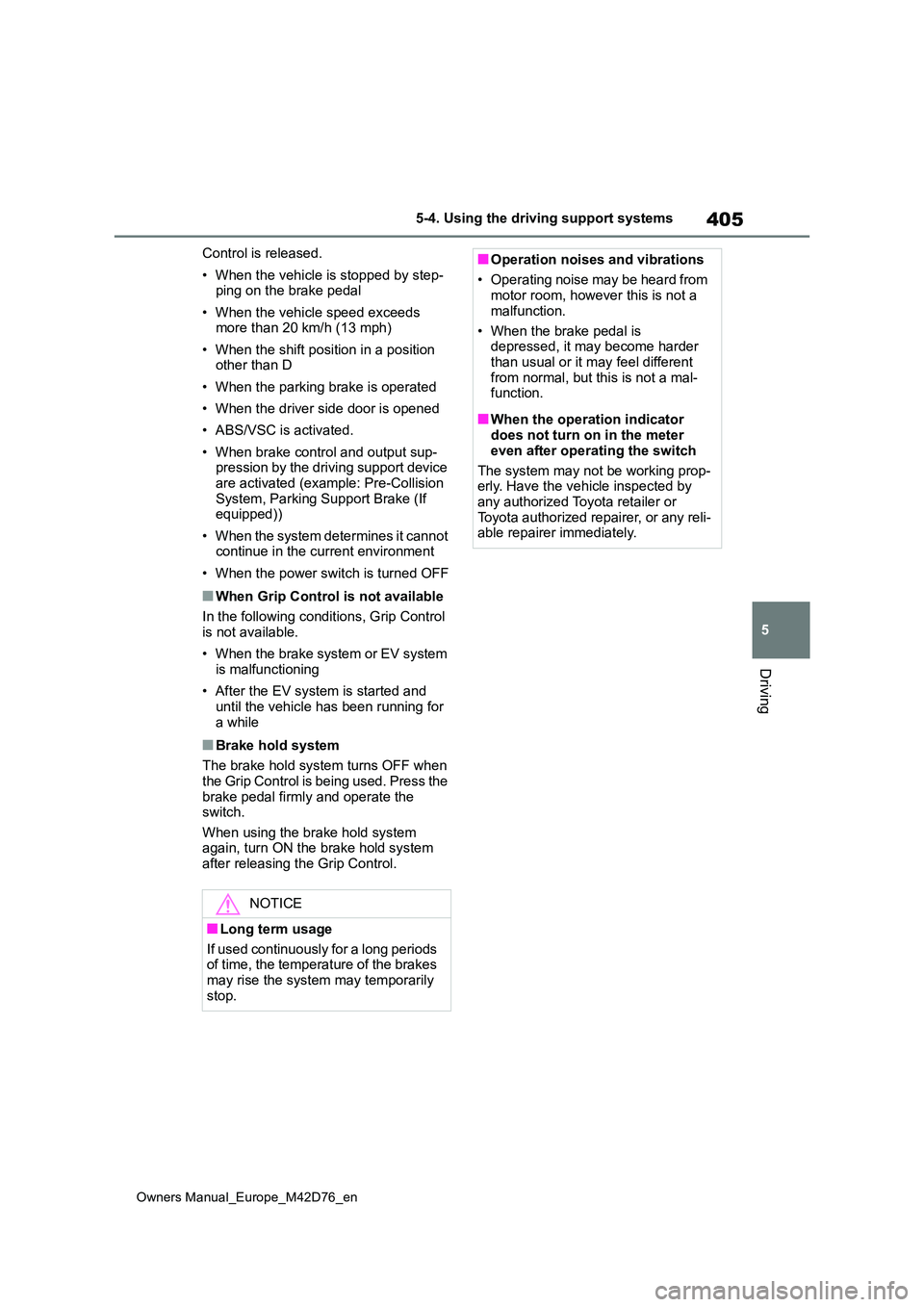
405
5
Owners Manual_Europe_M42D76_en
5-4. Using the driving support systems
Driving
Control is released.
• When the vehicle is stopped by step- ping on the brake pedal
• When the vehicle speed exceeds more than 20 km/h (13 mph)
• When the shift position in a position other than D
• When the parking brake is operated
• When the driver side door is opened
• ABS/VSC is activated.
• When brake control and output sup- pression by the driving support device
are activated (example: Pre-Collision System, Parking Support Brake (If equipped))
• When the system determines it cannot continue in the current environment
• When the power switch is turned OFF
■When Grip Control is not available
In the following conditions, Grip Control
is not available.
• When the brake system or EV system
is malfunctioning
• After the EV system is started and
until the vehicle has been running for a while
■Brake hold system
The brake hold system turns OFF when
the Grip Control is being used. Press the brake pedal firmly and operate the switch.
When using the brake hold system again, turn ON the brake hold system after releasing the Grip Control.
NOTICE
■Long term usage
If used continuously for a long periods of time, the temperature of the brakes
may rise the system may temporarily stop.
■Operation noises and vibrations
• Operating noise may be heard from motor room, however this is not a
malfunction.
• When the brake pedal is depressed, it may become harder
than usual or it may feel different from normal, but this is not a mal-function.
■When the operation indicator does not turn on in the meter
even after operating the switch
The system may not be working prop- erly. Have the vehicle inspected by
any authorized Toyota retailer or Toyota authorized repairer, or any reli-able repairer immediately.
Page 408 of 674
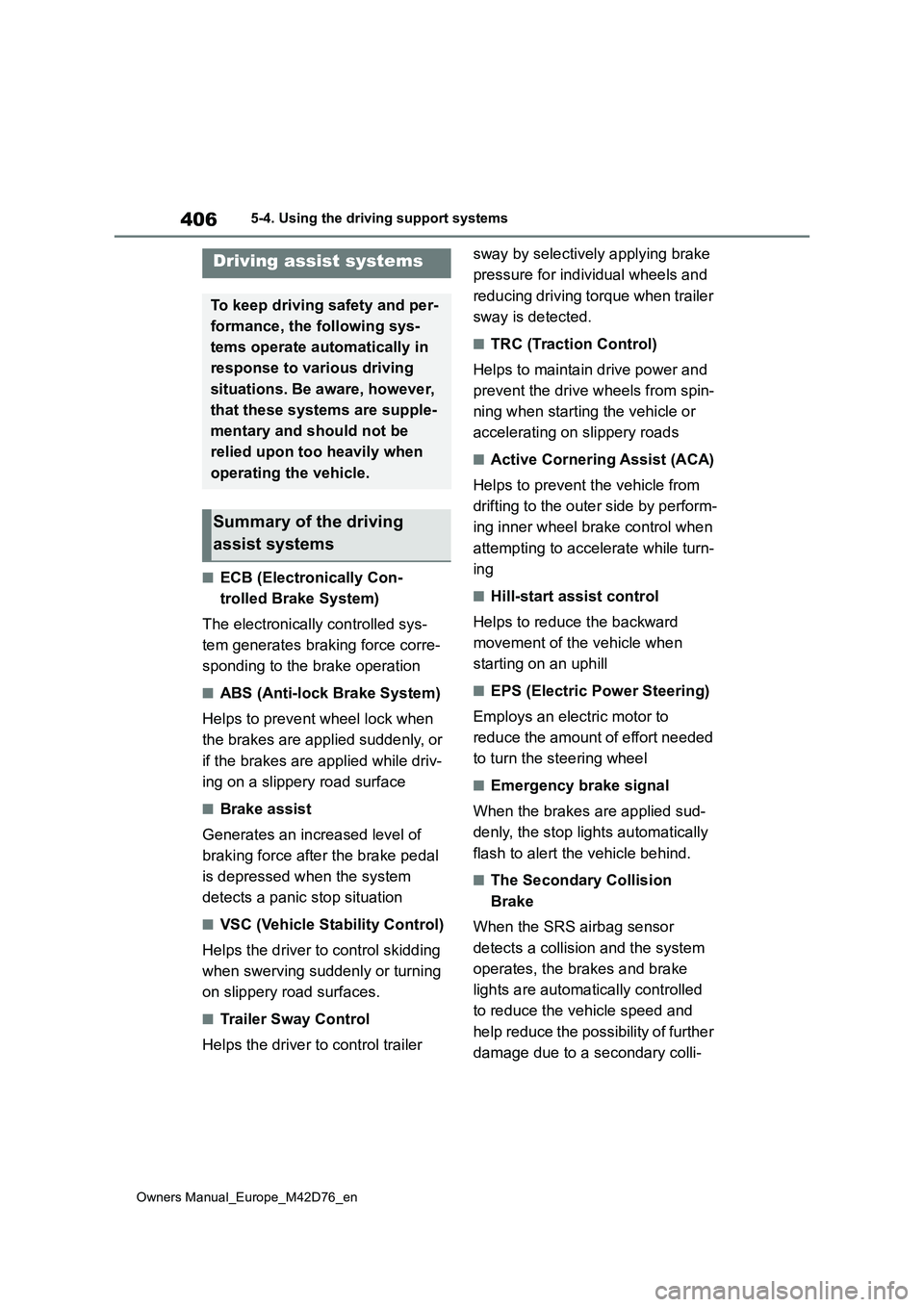
406
Owners Manual_Europe_M42D76_en
5-4. Using the driving support systems
■ECB (Electronically Con-
trolled Brake System)
The electronically controlled sys-
tem generates braking force corre-
sponding to the brake operation
■ABS (Anti-lock Brake System)
Helps to prevent wheel lock when
the brakes are applied suddenly, or
if the brakes are applied while driv-
ing on a slippery road surface
■Brake assist
Generates an increased level of
braking force after the brake pedal
is depressed when the system
detects a panic stop situation
■VSC (Vehicle Stability Control)
Helps the driver to control skidding
when swerving suddenly or turning
on slippery road surfaces.
■Trailer Sway Control
Helps the driver to control trailer
sway by selectively applying brake
pressure for individual wheels and
reducing driving torque when trailer
sway is detected.
■TRC (Traction Control)
Helps to maintain drive power and
prevent the drive wheels from spin-
ning when starting the vehicle or
accelerating on slippery roads
■Active Cornering Assist (ACA)
Helps to prevent the vehicle from
drifting to the outer side by perform-
ing inner wheel brake control when
attempting to accelerate while turn-
ing
■Hill-start assist control
Helps to reduce the backward
movement of the vehicle when
starting on an uphill
■EPS (Electric Power Steering)
Employs an electric motor to
reduce the amount of effort needed
to turn the steering wheel
■Emergency brake signal
When the brakes are applied sud-
denly, the stop lights automatically
flash to alert the vehicle behind.
■The Secondary Collision
Brake
When the SRS airbag sensor
detects a collision and the system
operates, the brakes and brake
lights are automatically controlled
to reduce the vehicle speed and
help reduce the possibility of further
damage due to a secondary colli-
Driving assist systems
To keep driving safety and per-
formance, the f ollowing sys-
tems operate automatically in
response to various driving
situations. Be aware, however,
that these systems are supple-
mentary and should not be
relied upon too heavily when
operating the vehicle.
Summary of the driving
assist systems
Page 409 of 674
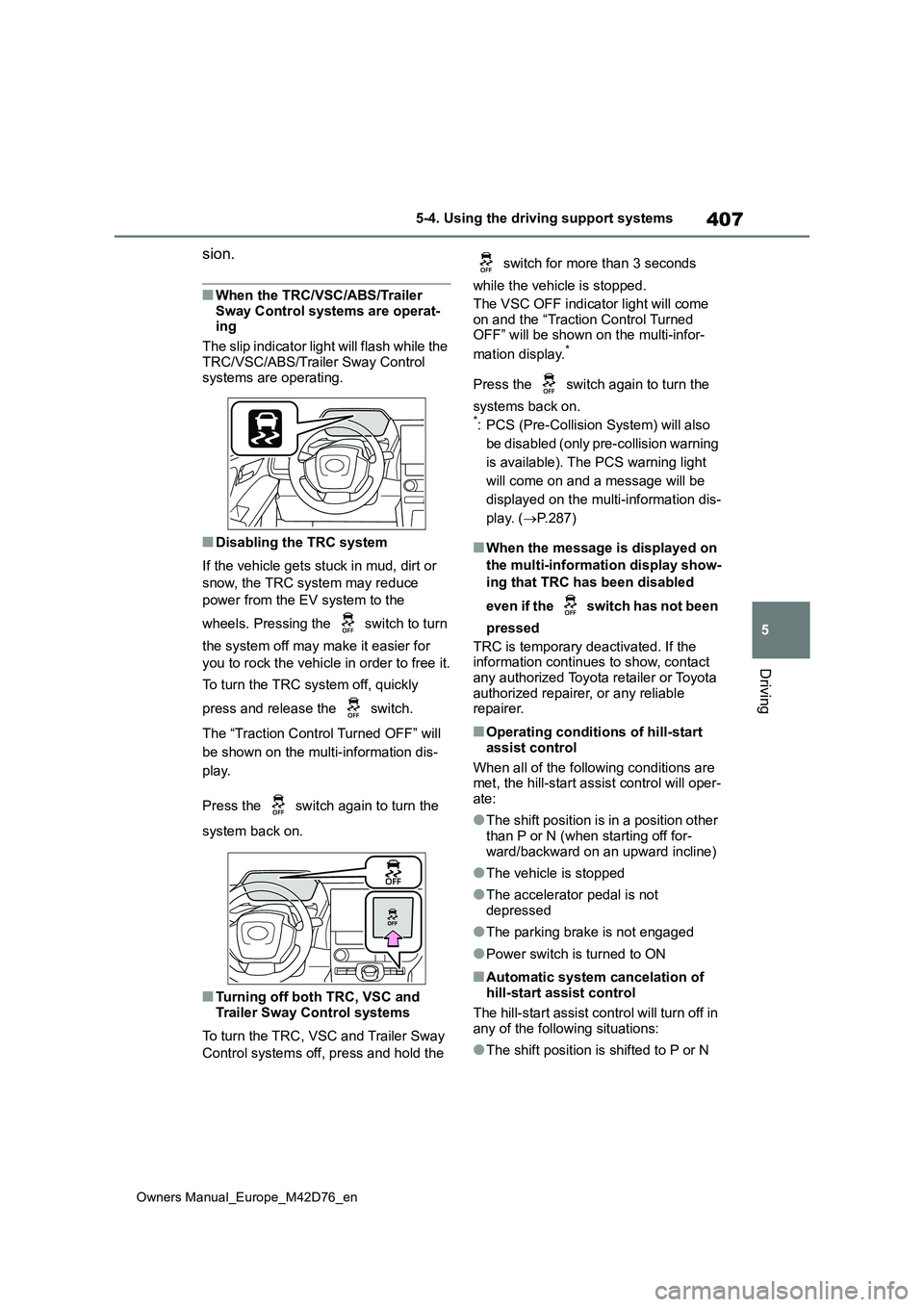
407
5
Owners Manual_Europe_M42D76_en
5-4. Using the driving support systems
Driving
sion.
■When the TRC/VSC/ABS/Trailer
Sway Control systems are operat- ing
The slip indicator light will flash while the
TRC/VSC/ABS/Trailer Sway Control systems are operating.
■Disabling the TRC system
If the vehicle gets stuck in mud, dirt or
snow, the TRC system may reduce
power from the EV system to the
wheels. Pressing the switch to turn
the system off may make it easier for
you to rock the vehicle in order to free it.
To turn the TRC system off, quickly
press and release the switch.
The “Traction Control Turned OFF” will
be shown on the multi-information dis-
play.
Press the switch again to turn the
system back on.
■Turning off both TRC, VSC and Trailer Sway Control systems
To turn the TRC, VSC and Trailer Sway
Control systems off, press and hold the
switch for more than 3 seconds
while the vehicle is stopped.
The VSC OFF indicator light will come on and the “Traction Control Turned OFF” will be shown on the multi-infor-
mation display.*
Press the switch again to turn the
systems back on.*: PCS (Pre-Collision System) will also
be disabled (only pre-collision warning
is available). The PCS warning light
will come on and a message will be
displayed on the multi-information dis-
play. ( P.287)
■When the message is displayed on
the multi-information display show-
ing that TRC has been disabled
even if the switch has not been
pressed
TRC is temporary deactivated. If the information continues to show, contact
any authorized Toyota retailer or Toyota authorized repairer, or any reliable repairer.
■Operating conditions of hill-start
assist control
When all of the following conditions are met, the hill-start assist control will oper-
ate:
●The shift position is in a position other
than P or N (when starting off for- ward/backward on an upward incline)
●The vehicle is stopped
●The accelerator pedal is not
depressed
●The parking brake is not engaged
●Power switch is turned to ON
■Automatic system cancelation of hill-start assist control
The hill-start assist control will turn off in any of the following situations:
●The shift position is shifted to P or N
Page 410 of 674
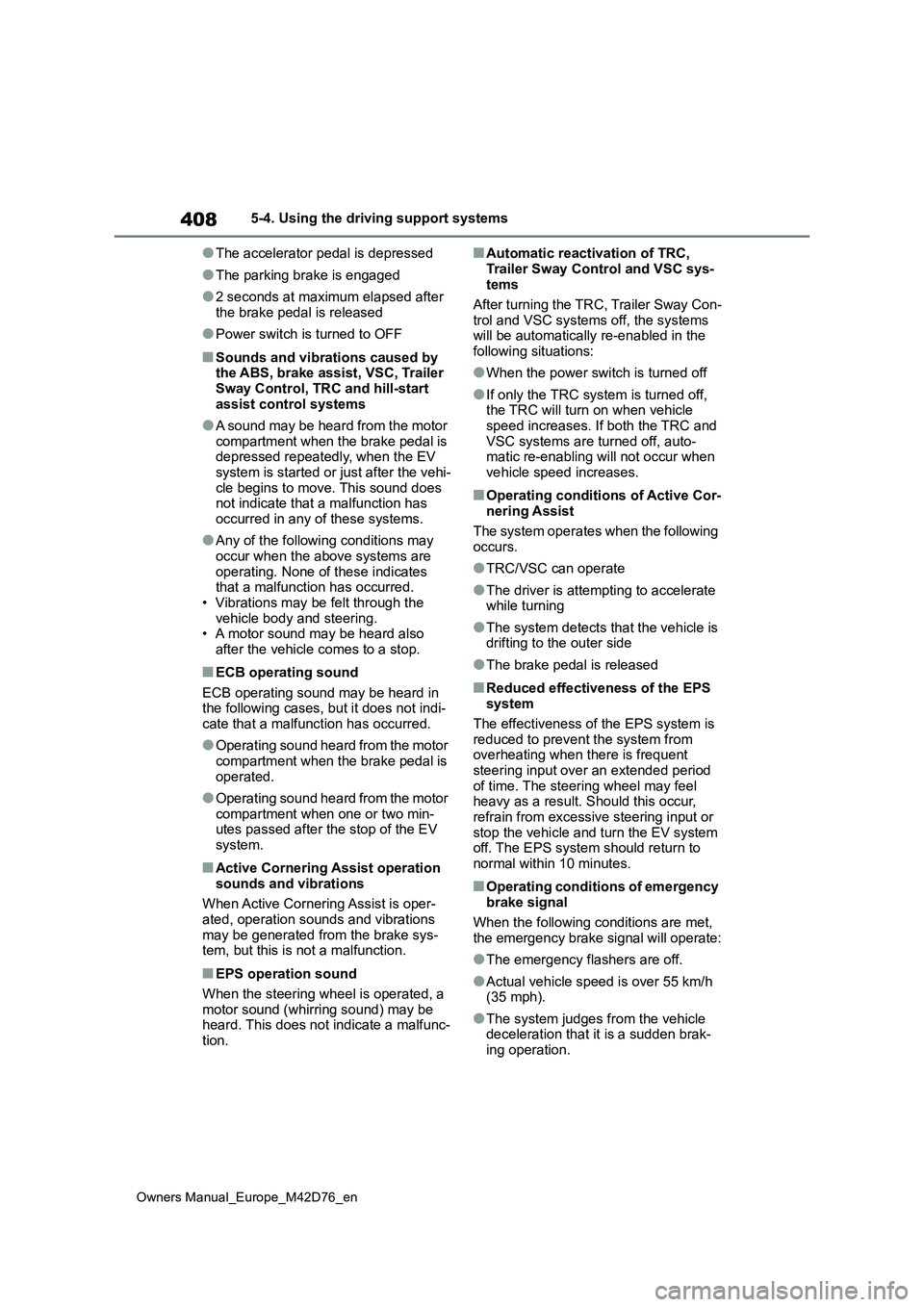
408
Owners Manual_Europe_M42D76_en
5-4. Using the driving support systems
●The accelerator pedal is depressed
●The parking brake is engaged
●2 seconds at maximum elapsed after the brake pedal is released
●Power switch is turned to OFF
■Sounds and vibrations caused by the ABS, brake assist, VSC, Trailer Sway Control, TRC and hill-start
assist control systems
●A sound may be heard from the motor
compartment when the brake pedal is depressed repeatedly, when the EV system is started or just after the vehi-
cle begins to move. This sound does not indicate that a malfunction has occurred in any of these systems.
●Any of the following conditions may occur when the above systems are
operating. None of these indicates that a malfunction has occurred.• Vibrations may be felt through the
vehicle body and steering. • A motor sound may be heard also after the vehicle comes to a stop.
■ECB operating sound
ECB operating sound may be heard in the following cases, but it does not indi-cate that a malfunction has occurred.
●Operating sound heard from the motor compartment when the brake pedal is
operated.
●Operating sound heard from the motor
compartment when one or two min- utes passed after the stop of the EV system.
■Active Cornering Assist operation
sounds and vibrations
When Active Cornering Assist is oper- ated, operation sounds and vibrations
may be generated from the brake sys- tem, but this is not a malfunction.
■EPS operation sound
When the steering wheel is operated, a
motor sound (whirring sound) may be heard. This does not indicate a malfunc-tion.
■Automatic reactivation of TRC,
Trailer Sway Control and VSC sys- tems
After turning the TRC, Trailer Sway Con-
trol and VSC systems off, the systems will be automatically re-enabled in the following situations:
●When the power switch is turned off
●If only the TRC system is turned off, the TRC will turn on when vehicle speed increases. If both the TRC and
VSC systems are turned off, auto- matic re-enabling will not occur when vehicle speed increases.
■Operating conditions of Active Cor-
nering Assist
The system operates when the following occurs.
●TRC/VSC can operate
●The driver is attempting to accelerate while turning
●The system detects that the vehicle is drifting to the outer side
●The brake pedal is released
■Reduced effectiveness of the EPS system
The effectiveness of the EPS system is
reduced to prevent the system from overheating when there is frequent steering input over an extended period
of time. The steering wheel may feel heavy as a result. Should this occur, refrain from excessive steering input or
stop the vehicle and turn the EV system off. The EPS system should return to normal within 10 minutes.
■Operating conditions of emergency
brake signal
When the following conditions are met, the emergency brake signal will operate:
●The emergency flashers are off.
●Actual vehicle speed is over 55 km/h (35 mph).
●The system judges from the vehicle deceleration that it is a sudden brak-ing operation.
Page 411 of 674
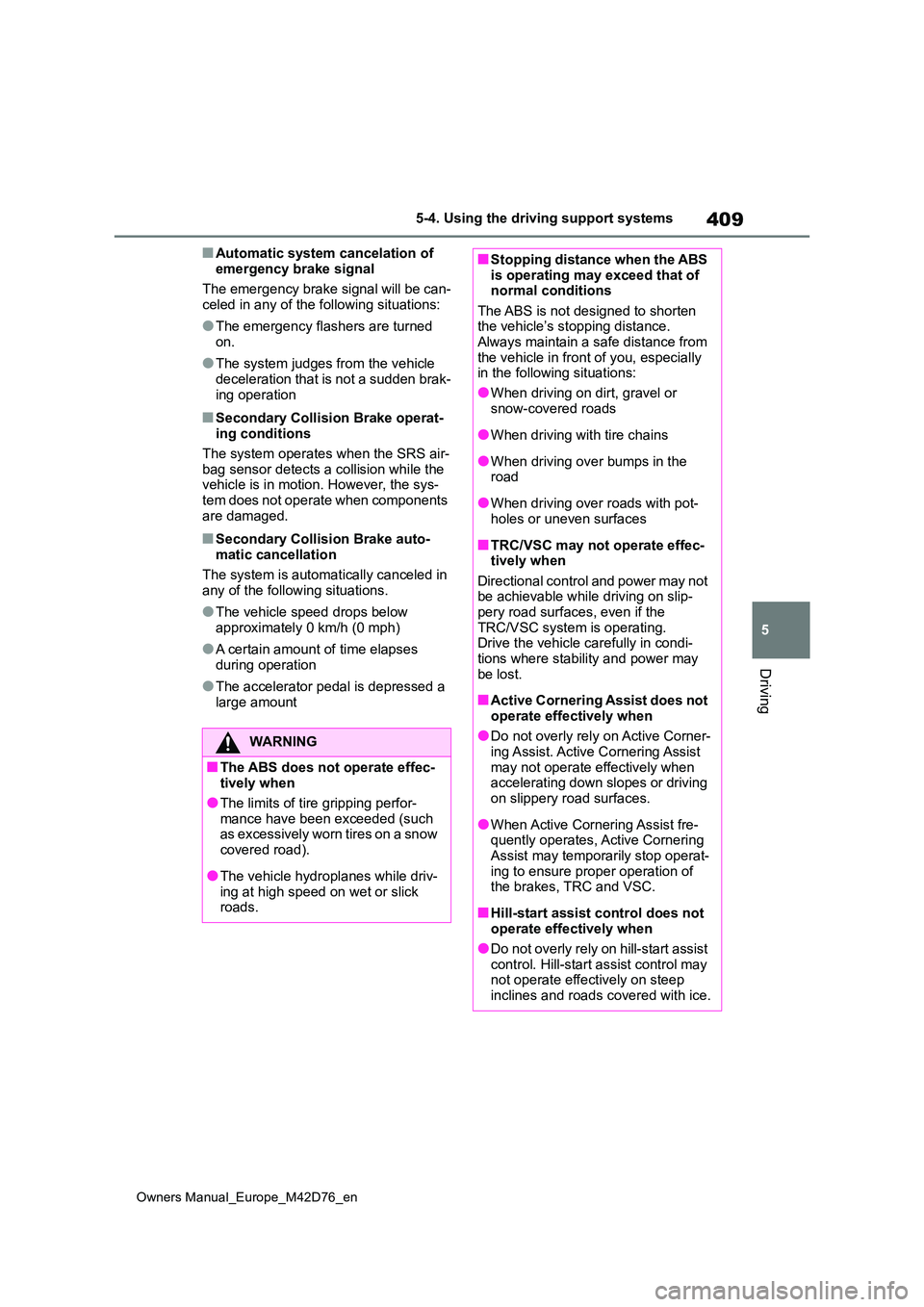
409
5
Owners Manual_Europe_M42D76_en
5-4. Using the driving support systems
Driving
■Automatic system cancelation of
emergency brake signal
The emergency brake signal will be can- celed in any of the following situations:
●The emergency flashers are turned on.
●The system judges from the vehicle deceleration that is not a sudden brak-
ing operation
■Secondary Collision Brake operat- ing conditions
The system operates when the SRS air-
bag sensor detects a collision while the vehicle is in motion. However, the sys-tem does not operate when components
are damaged.
■Secondary Collision Brake auto- matic cancellation
The system is automatically canceled in
any of the following situations.
●The vehicle speed drops below
approximately 0 km/h (0 mph)
●A certain amount of time elapses
during operation
●The accelerator pedal is depressed a
large amount
WARNING
■The ABS does not operate effec- tively when
●The limits of tire gripping perfor-mance have been exceeded (such as excessively worn tires on a snow
covered road).
●The vehicle hydroplanes while driv-
ing at high speed on wet or slick roads.
■Stopping distance when the ABS is operating may exceed that of normal conditions
The ABS is not designed to shorten the vehicle’s stopping distance. Always maintain a safe distance from
the vehicle in front of you, especially in the following situations:
●When driving on dirt, gravel or
snow-covered roads
●When driving with tire chains
●When driving over bumps in the road
●When driving over roads with pot-holes or uneven surfaces
■TRC/VSC may not operate effec-tively when
Directional control and power may not be achievable while driving on slip-pery road surfaces, even if the
TRC/VSC system is operating. Drive the vehicle carefully in condi-tions where stability and power may
be lost.
■Active Cornering Assist does not
operate effectively when
●Do not overly rely on Active Corner- ing Assist. Active Cornering Assist
may not operate effectively when accelerating down slopes or driving on slippery road surfaces.
●When Active Cornering Assist fre-quently operates, Active Cornering
Assist may temporarily stop operat- ing to ensure proper operation of the brakes, TRC and VSC.
■Hill-start assist control does not operate effectively when
●Do not overly rely on hill-start assist control. Hill-start assist control may not operate effectively on steep
inclines and roads covered with ice.
Page 425 of 674
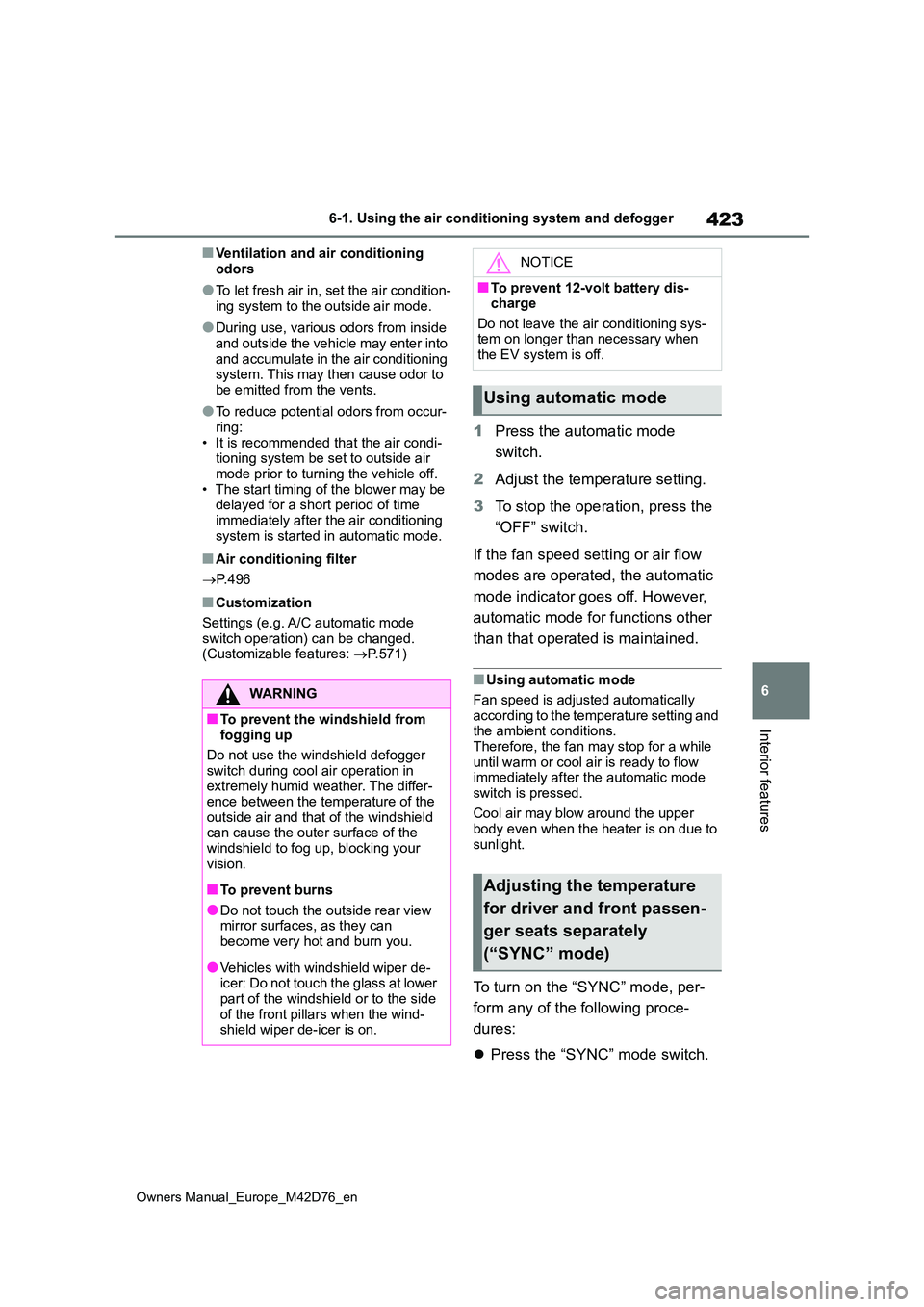
423
6
Owners Manual_Europe_M42D76_en
6-1. Using the air conditioning system and defogger
Interior features
■Ventilation and air conditioning
odors
●To let fresh air in, set the air condition-
ing system to the outside air mode.
●During use, various odors from inside
and outside the vehicle may enter into and accumulate in the air conditioning system. This may then cause odor to
be emitted from the vents.
●To reduce potential odors from occur-
ring: • It is recommended that the air condi-tioning system be set to outside air
mode prior to turning the vehicle off. • The start timing of the blower may be delayed for a short period of time
immediately after the air conditioning system is started in automatic mode.
■Air conditioning filter
P. 4 9 6
■Customization
Settings (e.g. A/C automatic mode switch operation) can be changed.(Customizable features: P.571)
1Press the automatic mode
switch.
2 Adjust the temperature setting.
3 To stop the operation, press the
“OFF” switch.
If the fan speed setting or air flow
modes are operated, the automatic
mode indicator goes off. However,
automatic mode for functions other
than that operated is maintained.
■Using automatic mode
Fan speed is adjusted automatically according to the temperature setting and the ambient conditions.
Therefore, the fan may stop for a while until warm or cool air is ready to flow immediately after the automatic mode
switch is pressed.
Cool air may blow around the upper body even when the heater is on due to
sunlight.
To turn on the “SYNC” mode, per-
form any of the following proce-
dures:
Press the “SYNC” mode switch.
WARNING
■To prevent the windshield from fogging up
Do not use the windshield defogger
switch during cool air operation in extremely humid weather. The differ-ence between the temperature of the
outside air and that of the windshield can cause the outer surface of the windshield to fog up, blocking your
vision.
■To prevent burns
●Do not touch the outside rear view mirror surfaces, as they can become very hot and burn you.
●Vehicles with windshield wiper de-icer: Do not touch the glass at lower
part of the windshield or to the side of the front pillars when the wind-shield wiper de-icer is on.
NOTICE
■To prevent 12-volt battery dis-charge
Do not leave the air conditioning sys- tem on longer than necessary when the EV system is off.
Using automatic mode
Adjusting the temperature
for driver and front passen-
ger seats separately
(“SYNC” mode)
Page 427 of 674

425
6
Owners Manual_Europe_M42D76_en
6-1. Using the air conditioning system and defogger
Interior features
This function automatically controls
the air conditioning airflow so that
priority is given to the front seats.
Unnecessary air conditioning is
suppressed, contributing to
increased electricity consumption
efficiency.
Front seat concentrated airflow
mode operates in the following situ-
ations.
No passengers are detected in
the rear seats
The windshield defogger is not
operating
While operating, illuminates.
■Manually turning front seat
concentrated airflow mode
on/off
In front seat concentrated airflow
mode, directing airflow to the front
seats only and to all seats can be
switched via switch operation.
When the mode has been switched
manually, automatic airflow control
stops operating.
Press on the air conditioning
operation panel and switch the air-
flow.
Indicator illuminated: Airflow to
the front seats only
Indicator off: Airflow to all the
seats
■Operation of automatic airflow con- trol
●In order to maintain a comfortable interior, airflow may be directed to seats without passengers immediately
after the EV system is started and at other times depending on the outside temperature.
●After the EV system is started, if pas-sengers move around inside or
enter/exit the vehicle, the system can- not accurately detect the presence of passengers and automatic airflow
control will not operate.
■Operation of manual airflow control
Even if the function is manually switched to directing airflow to only the front
seats, when a rear seat is occupied, it may automatically direct airflow to all seats.
■To return to automatic airflow con-
trol
1 With the indicator off, turn the power switch off.
2 After 60 minutes or more elapse, turn the power switch to ON.
WARNING
■To prevent the windshield defog-ger from operating improperly
Do not place anything on the instru- ment panel which may cover the air outlets. Otherwise, air flow may be
obstructed, preventing the windshield defoggers from defogging.
Front seat concentrated air-
flow mode (S-FLOW)
Page 429 of 674
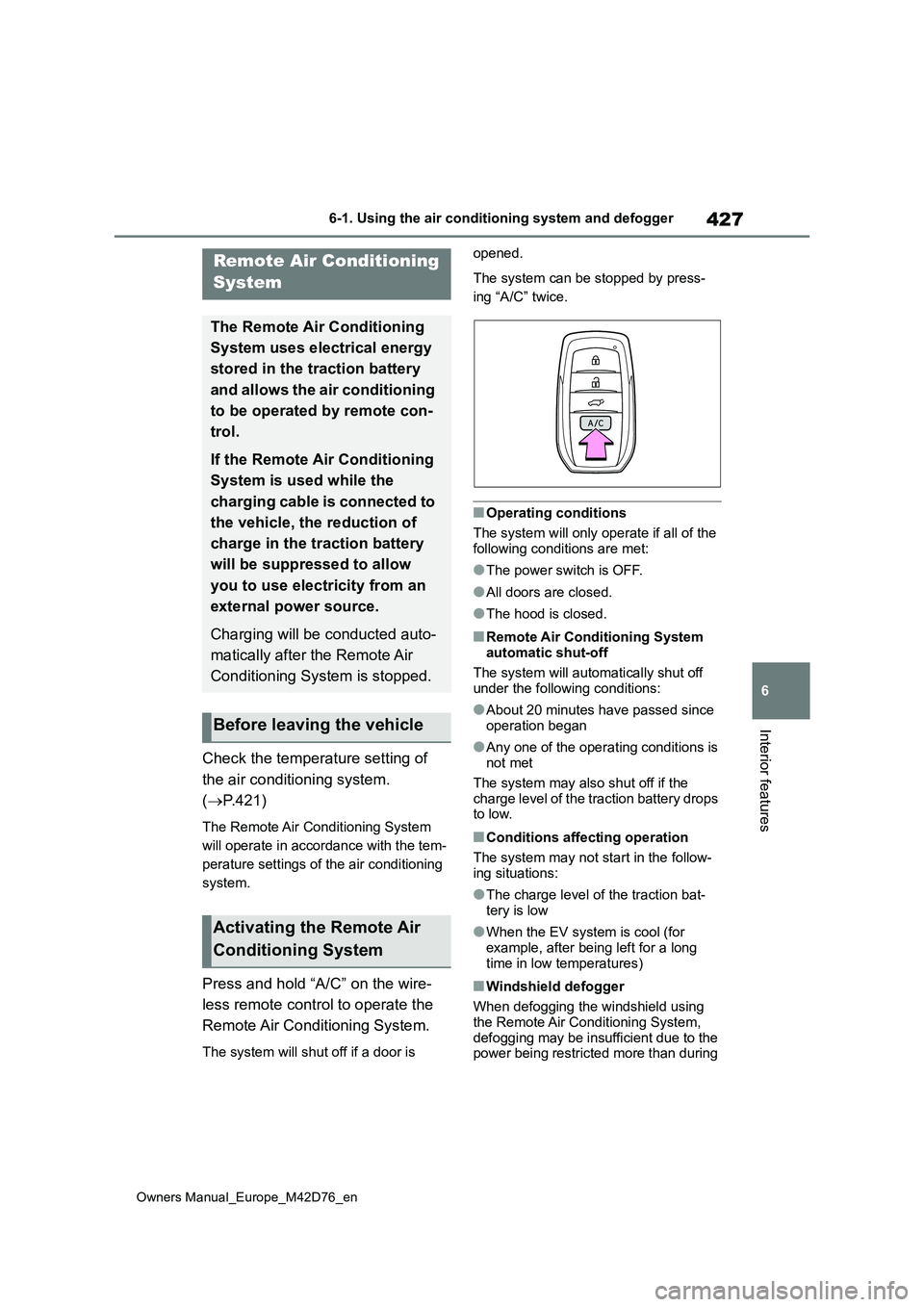
427
6
Owners Manual_Europe_M42D76_en
6-1. Using the air conditioning system and defogger
Interior features
Check the temperature setting of
the air conditioning system.
( P.421)
The Remote Air Conditioning System
will operate in accordance with the tem-
perature settings of the air conditioning
system.
Press and hold “A/C” on the wire-
less remote control to operate the
Remote Air Conditioning System.
The system will shut off if a door is
opened.
The system can be stopped by press-
ing “A/C” twice.
■Operating conditions
The system will only operate if all of the following conditions are met:
●The power switch is OFF.
●All doors are closed.
●The hood is closed.
■Remote Air Conditioning System
automatic shut-off
The system will automatically shut off under the following conditions:
●About 20 minutes have passed since operation began
●Any one of the operating conditions is not met
The system may also shut off if the charge level of the traction battery drops to low.
■Conditions affecting operation
The system may not start in the follow- ing situations:
●The charge level of the traction bat-tery is low
●When the EV system is cool (for example, after being left for a long
time in low temperatures)
■Windshield defogger
When defogging the windshield using the Remote Air Conditioning System,
defogging may be insufficient due to the power being restricted more than during
Remote Air Conditioning
System
The Remote Air Conditioning
System uses electrical energy
stored in the traction battery
and allows the air conditioning
to be operated by remote con-
trol.
If the Remote Air Conditioning
System is used while the
charging cable is connected to
the vehicle, the reduction of
charge in the traction battery
will be suppressed to allow
you to use electricity from an
external power source.
Charging will be conducted auto-
matically after the Remote Air
Conditioning System is stopped.
Before leaving the vehicle
Activating the Remote Air
Conditioning System